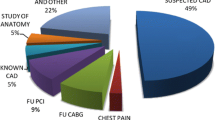Abstract
Background
The cardiac CT (CCT) appropriateness criteria (AC) were jointly published by multiple societies to ensure effective utilization of CCT. We sought to determine how these criteria apply to CCT scans performed at a tertiary-care hospital.
Methods and Results
Data were collected from medical records and interviews of 267 consecutive patients referred for CCT. Two physicians designated exam indication as appropriate, inappropriate, or uncertain as per AC, or “not known” if not listed in AC. CCT exam indication was appropriate in 47%, inappropriate in 9%, uncertain in 15%, and not known in 29%. The most common appropriate indication was evaluation of CAD in symptomatic patients with equivocal stress test, whereas the most common inappropriate referral was evaluation of asymptomatic patients with low pretest probability of CAD. Most exams (69%) were for evaluation of CAD, with the remaining exams performed to evaluate other elements of cardiac structure or function. Exams for these non-CAD indications were more likely to be appropriate and less likely to have an undetermined (uncertain or not known) level of appropriateness than those for CAD indications. There was no difference in exam appropriateness whether ordered by cardiologists or internists, but providers who completed training >25 years ago ordered fewer appropriate and more inappropriate exams than younger providers.
Conclusions
In applying the AC to a large academic medical center, few CCT exams were inappropriate; however, many patients referred for CCT, particularly for evaluation of CAD, had an indication for which the level of appropriateness remained undetermined. Given the rapid adoption of CCT, these results emphasize the need to refine current criteria for appropriate utilization.


Similar content being viewed by others
References
Hendel RC, Patel MR, Kramer CM, Poon M, Hendel RC, Carr JC, et al. ACCF/ACR/SCCT/SCMR/ASNC/NASCI/SCAI/SIR 2006 appropriateness criteria for cardiac computed tomography and cardiac magnetic resonance imaging: A report of the American College of Cardiology Foundation Quality Strategic Directions Committee Appropriateness Criteria Working Group, American College of Radiology, Society of Cardiovascular Computed Tomography, Society for Cardiovascular Magnetic Resonance, American Society of Nuclear Cardiology, North American Society for Cardiac Imaging, Society for Cardiovascular Angiography and Interventions, and Society of Interventional Radiology. J Am Coll Cardiol 2006;48:1475-97.
Bonow RO. Sixth Annaul Mario S. Verani, MD Memorial Lecture: Cardiovascular imaging—added value or added cost? J Nucl Cardiol 2008;15:170-7.
Lucas FL, DeLorenzo MA, Siewers AE, Wennberg DE. Temporal trends in the utilization of diagnostic testing and treatments for cardiovascular disease in the United States, 1993–2001. Circulation 2006;113:374-9.
Ayyad AE, Cole J, Syed A, Desai MY, Halliburton S, Schoenhagen P, et al. Temporal trends in utilization of cardiac computed tomography. J Cardiovasc Comput Tomogr 2009;3:16-21.
Executive summary of the third report of the National Cholesterol Education Program (NCEP) expert panel on detection, evaluation, and treatment of high blood cholesterol in adults (Adult Treatment Panel III). JAMA 2001;285:2486-97.
Diamond GA, Forrester JS. Analysis of probability as an aid in the clinical diagnosis of coronary-artery disease. N Engl J Med 1979;300:1350-8.
Eagle KA, Berger PB, Calkins H, Chaitman BR, Ewy GA, Fleischmann KE, et al. ACC/AHA guideline update for perioperative cardiovascular evaluation for noncardiac surgery—executive summary: A report of the American College of Cardiology/American Heart Association Task Force on Practice Guidelines (Committee to Update the 1996 Guidelines on Perioperative Cardiovascular Evaluation for Noncardiac Surgery). J Am Coll Cardiol 2002;39:542-53.
Fleisher LA, Beckman JA, Brown KA, Calkins H, Chaikof EL, Fleischmann KE, et al. ACC/AHA 2007 guidelines on perioperative cardiovascular evaluation and care for noncardiac surgery—executive summary: A report of the American College of Cardiology/American Heart Association Task Force on Practice Guidelines (Writing Committee to Revise the 2002 Guidelines on Perioperative Cardiovascular Evaluation for Noncardiac Surgery) developed in collaboration with the American Society of Echocardiography, American Society of Nuclear Cardiology, Heart Rhythm Society, Society of Cardiovascular Anesthesiologists, Society for Cardiovascular Angiography and Interventions, Society for Vascular Medicine and Biology, and Society for Vascular Surgery. J Am Coll Cardiol 2007;50:1707-32.
Blankstein R, Di Carli MF. Integration of coronary anatomy and myocardial perfusion imaging. Nat Rev Cardiol 2010;7:226-36.
Pryor DB, Harrell FE Jr, Lee KL, Califf RM, Rosati RA. Estimating the likelihood of significant coronary artery disease. Am J Med 1983;75:771-80.
Author information
Authors and Affiliations
Corresponding author
Additional information
Drs Blankstein, Nasir, and Truong have received support from NIH Grant 1T32 HL076136-02. This study was partially funded by an internal grant from Partners HealthCare, Boston, MA, USA.
Appendix 1
Appendix 1
Exam Indications not included in 2006 AC (N = 78):
-
Preoperative evaluation for CAD for cardiac surgery
-
Detection of CAD in symptomatic patient with low pretest probability of CAD
-
Detection of CAD in symptomatic patient with negative stress test
-
Detection of CAD in symptomatic patient with mildly positive stress test
-
Evaluation of left atrial appendage watchman device
-
Post-pulmonary vein ablation, concern for pulmonary vein stenosis
-
After invasive angiography to further evaluate a vessel unable to be visualized well on cath
-
Monitoring after repair of ascending aortic aneurysm
-
Chest pain syndrome, high pretest probability, invasive angiography not clinically appropriate
-
Chest pain syndrome, moderate/severe ischemia on stress test, invasive angiography not clinically appropriate
-
Asymptomatic, equivocal stress test
-
Asymptomatic, mildly positive stress test
Rights and permissions
About this article
Cite this article
Murphy, M.K., Brady, T.J., Nasir, K. et al. Appropriateness and utilization of cardiac CT: Implications for development of future criteria. J. Nucl. Cardiol. 17, 881–889 (2010). https://doi.org/10.1007/s12350-010-9252-0
Received:
Accepted:
Published:
Issue Date:
DOI: https://doi.org/10.1007/s12350-010-9252-0




